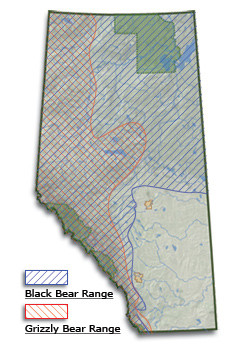Government mail service may be affected by the Canada Post labour disruption. Learn about how critical government mail will be handled.
The map shows the distribution of black bears in Alberta during the early 1990s; the current range encompasses some 488,000 km2 or about 74% of the province.
Recently, several sightings were reported near the City of Edmonton and other locations in central Alberta, suggesting that this species is extending its range into former habitats.
The dynamics of black bear populations were investigated in several areas during the 1970s and 1980s. These studies (locations shown on map; details in table) revealed a wide range of densities in different biogeographical zones, related to
- habitat values
- forest succession
- human development, as well as past levels of human use or control
Densities (bears/1,000 km2) varied from 370 at Cold Lake (a relatively high density) to eight at Banff National Park (a very low density).
Bear Density (bears/1,000 km2)
(historical estimates – 1970s and 1980s)

| Black Bear | Grizzly Bear | ||
|---|---|---|---|
| Cold | 370 | Waterton | 48 |
| Fort Hills | 333 | Kananaskis | 14 |
| Sheep River | 233 | Jasper | 11 |
| Swan Hills | 18* | Swan Hills | 8 |
| Berland | 9* | South Wapiti | 7 |
| Banff | 8 | Berland | 5 |
Such estimates were derived by monitoring several bears in each area with the use of radio telemetry.
Ranges occupied by adult female black bears are generally quite mutually exclusive; that is, there is usually a minimum of overlap between ranges of individual females. Thus, the known range size of adult female bears provides a useful index to regional bear populations (when female ranges are small, densities are greater; when large, densities are lesser).
Data from the Cold Lake study, conducted by Gerry Kemp of Alberta Fish and Wildlife and Barry Young and Bob Ruff of the University of Wisconsin, indicated a high black bear population in excellent habitat (average female range =20 km²). This contrasts with a study in the Swan Hills following a period of active oil/gas exploration and development and known shootings of bears in the 1970's. John Nagy of the Canadian Wildlife Service reported large female ranges, a sign of low density.
In 1993, Alberta's total black bear population was estimated on the basis of landsat satellite imagery (forest cover, land disturbance), and estimated average bear densities from study areas.
The results provided a total of 36 000 bears (provincial lands) and 40 000 bears (all of Alberta). Calculated average density was 84 bears per 1000 km².
The Status of Alberta Wildlife lists black bears as a "green" species, which means it is "not at risk."
The Black Bear Response Guide was developed to help government officials take effective, consistent action when human-bear conflict occurs.
To read the guide, see:
Black Bear Rehabilitation
In 2018, Alberta introduced a new policy that allows licensed wildlife rehabilitation facilities in Alberta to accept orphaned black bear cubs with the appropriate approvals.
Under the policy, wildlife management biologists work with rehabilitation facilities to ensure bears can be returned to the wild without causing issues in populated areas.
This means the bears:
- are able to forage on their own
- are appropriately social with other bears
- are less likely to become a part of human-bear conflict
After being assessed, bears are released around October 15 of the year they arrived at the facility. Released bears are fitted with monitoring devices such as radio-collars and will be tracked by scientists to ensure successful reintegration into the wild.